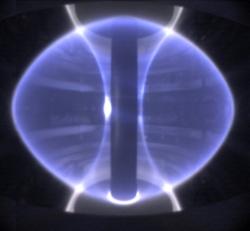| Mega Ampere Spherical Tokamak | |
|---|---|
 Plasma in the MAST reactor | |
| Device type | Spherical tokamak |
| Location | Culham, Oxfordshire, UK |
| Affiliation | Culham Centre for Fusion Energy |
| Technical specifications | |
| Major radius | ~ 0.9 m (2 ft 11 in) |
| Minor radius | ~ 0.6 m (2 ft 0 in) |
| Plasma volume | 8 m3 |
| Magnetic field | 0.55 T (5,500 G) |
| Heating power | 5 MW |
| Plasma current | 1.3 MA |
| History | |
| Date(s) of construction | 1997 |
| Year(s) of operation | 1999–2013 |
| Preceded by | Small Tight Aspect Ratio Tokamak (START) |
| Succeeded by | MAST-U |
The Mega Ampere Spherical Tokamak (MAST) experiment was a nuclear fusion experiment. It tested a spherical tokamak nuclear fusion reactor. MAST was commissioned by EURATOM/UKAEA. The experiment took place at Culham Centre for Fusion Energy, Oxfordshire, England. The experiment ran from December 1999 to September 2013. A successor facility called MAST Upgrade began operation in 2020.[1]
Design
A spherical tokamak is shaped more like a cored apple than the conventional, doughnut-shaped toroidal design used by experiments such as ITER. Spherical tokamaks are more efficient in their use of the magnetic field.
MAST included a neutral beam injector for plasma heating. It used a merging compression technique for plasma formation instead of the conventional direct induction. Merging compression saves central solenoid flux, which can then be used to increase the plasma current and/or maintain the required current flat-top.
MAST's plasma volume was about 8 m3. It confined plasmas with densities on the order of 1020/m3.
MAST's plasma had an almost circular outer profile. The extensions off the top and bottom are plasma flowing to the ring divertors, a key feature of modern tokamak designs.
Experiments
MAST confirmed the increased operating efficiency of spherical tokamaks – demonstrating a high beta (ratio of plasma pressure to the pressure from the confining magnetic field). MAST performed experiments on controlling and mitigating instabilities at the edge of the plasma – so-called Edge Localised Modes or ELMs.
History
The Small Tight Aspect Ratio Tokamak (START) experiment (1991-1998) was an earlier spherical tokamak. START exceeded the most optimistic predictions and MAST confirmed its on a larger, more purpose-built experiment.
The MAST design occupied 1995-1997. Construction consumed 1997-1999. First plasma came in 1999.
Over its lifetime MAST produced 30471 plasmas (in pulses up to 0.5 sec). In October 2013 the reactor was shut down for upgrade.[2]
MAST Upgrade
MAST Upgrade is the successor experiment, also at Culham Centre. The upgrade cost £45M. It started in 2013 and was expected to significantly exceed MAST’s heating power, plasma current, magnetic field and pulse length.
MAST Upgrade began operation on 29 October 2020.[3]
One of MAST Upgrade's most notable features is the Super-X divertor. The divertor removes excess heat and impurities from the plasma. Conventional divertor designs, at powerplant scale, will experience high heat loads and will need to be regularly replaced. The Super-X divertor was expected to produce heat loads that are lower by around a factor of 10.
Spherical Tokamak for Energy Production
The design of the next generation Spherical Tokamak for Energy Production (STEP) began in 2019 with £220 million in government funding. The plan is begin operations in the 2040s.[4] Current plan is to not include a tritium generation facility.[5]
See also
- National Spherical Torus Experiment, US version - 1st plasma 1999.
- List of fusion experiments
- ELM (Edge Localized Mode)
- Ball-pen probe
- Langmuir probe
- Resonant magnetic perturbations
References
- ^ "MAST Upgrade Research Plan, November 2019" (PDF). Culham Centre for Fusion Energy. Retrieved 2020-10-26.
- ^ "News: It's goodbye to MAST - and hello to MAST Upgrade". Ccfe.ac.uk. Retrieved 2015-12-11.
- ^ Rincon, Paul (2020-10-29). "UK fusion experiment used in hunt for clean energy". BBC News Online. Retrieved 2020-10-30.
- ^ "STEP". Culham Centre for Fusion Energy. Retrieved 2020-11-27.
- ^ Clery, Daniel (2020-12-02). "U.K. seeks site for world's first fusion power station". Science. doi:10.1126/science.abf9768. ISSN 0036-8075.
External links
- MAST Main Page
- Photos of MAST
- First results from MAST. 2001 Summary of first 6 months
- MAST Upgrade Research Plan, November 2019